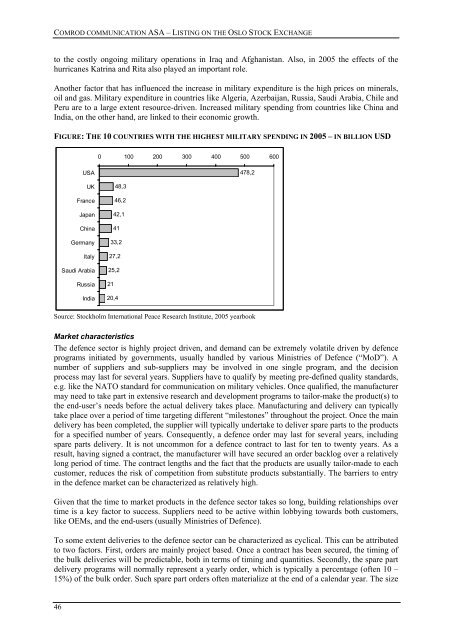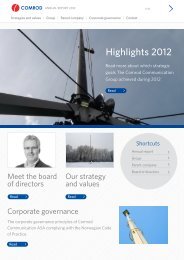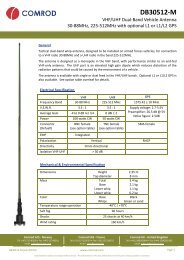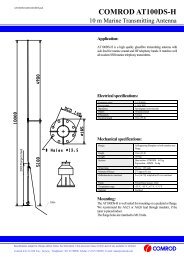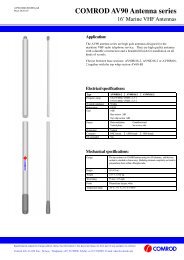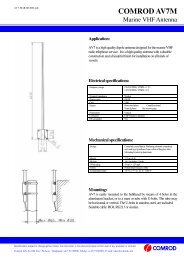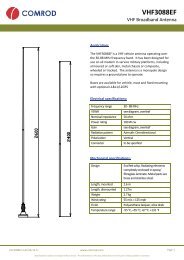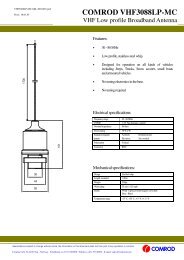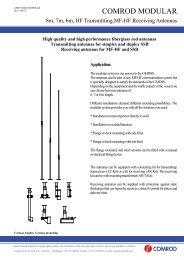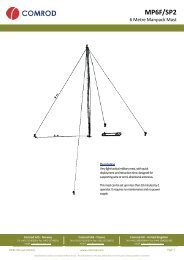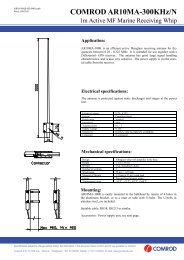English version - Hexagon Composites ASA
English version - Hexagon Composites ASA
English version - Hexagon Composites ASA
You also want an ePaper? Increase the reach of your titles
YUMPU automatically turns print PDFs into web optimized ePapers that Google loves.
COMROD COMMUNICATION <strong>ASA</strong> – LISTING ON THE OSLO STOCK EXCHANGE<br />
to the costly ongoing military operations in Iraq and Afghanistan. Also, in 2005 the effects of the<br />
hurricanes Katrina and Rita also played an important role.<br />
Another factor that has influenced the increase in military expenditure is the high prices on minerals,<br />
oil and gas. Military expenditure in countries like Algeria, Azerbaijan, Russia, Saudi Arabia, Chile and<br />
Peru are to a large extent resource-driven. Increased military spending from countries like China and<br />
India, on the other hand, are linked to their economic growth.<br />
FIGURE:THE 10 COUNTRIES WITH THE HIGHEST MILITARY SPENDING IN 2005 – IN BILLION USD<br />
0 100 200 300 400 500 600<br />
USA<br />
478,2<br />
UK<br />
France<br />
Japan<br />
China<br />
Germany<br />
Italy<br />
Saudi Arabia<br />
Russia<br />
India<br />
48,3<br />
46,2<br />
42,1<br />
41<br />
33,2<br />
27,2<br />
25,2<br />
21<br />
20,4<br />
Source: Stockholm International Peace Research Institute, 2005 yearbook<br />
Market characteristics<br />
The defence sector is highly project driven, and demand can be extremely volatile driven by defence<br />
programs initiated by governments, usually handled by various Ministries of Defence (“MoD”). A<br />
number of suppliers and sub-suppliers may be involved in one single program, and the decision<br />
process may last for several years. Suppliers have to qualify by meeting pre-defined quality standards,<br />
e.g. like the NATO standard for communication on military vehicles. Once qualified, the manufacturer<br />
may need to take part in extensive research and development programs to tailor-make the product(s) to<br />
the end-user’s needs before the actual delivery takes place. Manufacturing and delivery can typically<br />
take place over a period of time targeting different “milestones” throughout the project. Once the main<br />
delivery has been completed, the supplier will typically undertake to deliver spare parts to the products<br />
for a specified number of years. Consequently, a defence order may last for several years, including<br />
spare parts delivery. It is not uncommon for a defence contract to last for ten to twenty years. As a<br />
result, having signed a contract, the manufacturer will have secured an order backlog over a relatively<br />
long period of time. The contract lengths and the fact that the products are usually tailor-made to each<br />
customer, reduces the risk of competition from substitute products substantially. The barriers to entry<br />
in the defence market can be characterized as relatively high.<br />
Given that the time to market products in the defence sector takes so long, building relationships over<br />
time is a key factor to success. Suppliers need to be active within lobbying towards both customers,<br />
like OEMs, and the end-users (usually Ministries of Defence).<br />
To some extent deliveries to the defence sector can be characterized as cyclical. This can be attributed<br />
to two factors. First, orders are mainly project based. Once a contract has been secured, the timing of<br />
the bulk deliveries will be predictable, both in terms of timing and quantities. Secondly, the spare part<br />
delivery programs will normally represent a yearly order, which is typically a percentage (often 10 –<br />
15%) of the bulk order. Such spare part orders often materialize at the end of a calendar year. The size<br />
46


